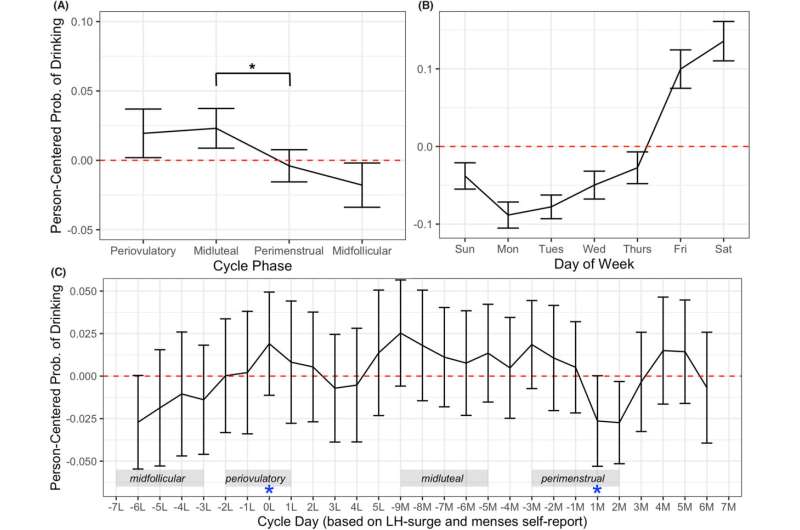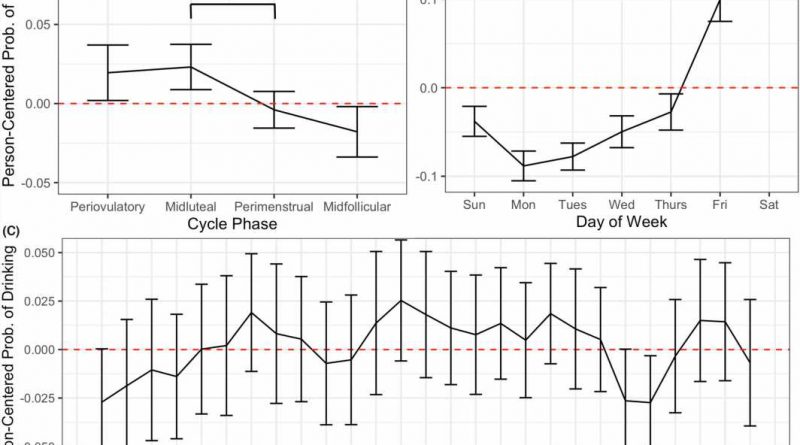Ovulation and menstruation trigger heavy drinking in psychiatric outpatients

People with psychiatric vulnerabilities that increase their risk of misusing alcohol appear more likely to drink heavily around the time of ovulation, especially on weekends, a new study suggests. The days around menstruation similarly carry a raised risk of heavy drinking—in this context, driven by attempts to cope with negative emotions that sometimes arise at that time. The findings come from the largest study so far to follow a clinical sample over time, exploring how the menstrual cycle influences drinking.
Women and girls (and others who menstruate) are experiencing steeper increases in the rate of alcohol use disorder than men and boys, and their problematic drinking is more likely to co-exist with mood or anxiety disorders—differences that may reflect in part the influence of cycling hormones.
Fluctuations in estrogen and progesterone are known to affect animals’ alcohol consumption. Studies in humans have yielded mixed results, perhaps reflecting varying research approaches and a lack of accounting for other powerful drivers, such as drinking motives.
For the study in Alcoholism: Clinical & Experimental Research, investigators at the University of Illinois at Chicago explored how alcohol use and drinking motives varied across the menstrual cycle of psychiatry outpatients and sought to improve on certain methodological limitations of previous studies.
Researchers drew on data from 94 participants aged 18–45, selected for having normal menstrual cycles and recent suicidal thinking. The participants were recruited for experimental studies about hormones and mood. For varying periods between 2017 and 2022, before receiving experimental hormones, participants provided daily self-reports covering their menstrual cycles, alcohol use, and motivations for drinking. Those motives were social (drinking to have fun with others), enhancing (for pleasant feelings), conforming (to fit in), or coping (to forget problems).
Using 3,721 resulting self-reports and urine testing to confirm ovulation, researchers categorized drinking and motives according to four phases of their cycles: mid-luteal (between ovulation and menstruation), perimenstrual (immediately before and during menstruation), mid-follicular (preceding ovulation), and periovulatory (around ovulation). They used statistical analysis to explore the relationship between these factors and accounted for differing behaviors on weekends.
Participants reported drinking on an average of 27% of the days they provided self-reports. Just over half said they drank heavily at least once, averaging five drinks per occasion. Overall, they were somewhat more likely to consume alcohol in the phase between ovulation and menstruation than during their menstrual periods.
Heavy weekend drinking, however, increased around the time of both ovulation and menstruation. Previous research has linked ovulation with increased alcohol intake and higher sensitivity to the rewarding properties of alcohol. In this study, weekend drinking was generally associated with increased periovulatory social motives—except just before or during menstruation. Around menstruation, there was greater drinking to cope (independent of the day of the week).
This is consistent with a previous study in a non-psychiatric sample; it suggests a link between perimenstrual emotional changes and increased alcohol use as a means of “self-medication”. That said, the influence of the menstrual cycle on alcohol use is individual and contextual and varies considerably. The menstrual cycle appears to play a role in heavy or “binge” drinking rather than low-risk drinking, which can serve a positive social function.
The study adds to evidence that menstrual cycles can make people more or less sensitive to environmental factors, such that cycle phase and weekends (for example) can interact to predict heavy drinking. The findings point to the clinical value of identifying who is at risk of experiencing cyclical changes in mood and behavior, whether these are accompanied by shifts in alcohol use, and what motivates those shifts.
More information:
Jordan C. Barone et al, Alcohol use and motives for drinking across the menstrual cycle in a psychiatric outpatient sample, Alcohol: Clinical and Experimental Research (2023). DOI: 10.1111/acer.14971
Journal information:
Alcoholism: Clinical & Experimental Research
Source: Read Full Article
